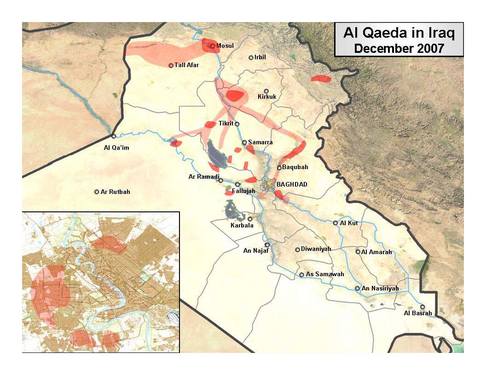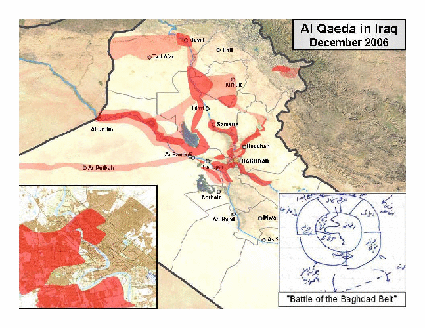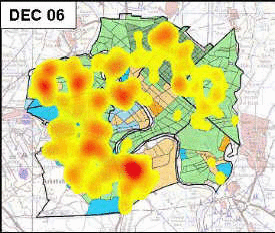Nearly one year to the day of the announcement of the “surge” of US forces to Iraq and the change in counterinsurgency plan, Iraqi and Coalition forces have shrunk al Qaeda’s ability to conduct operations inside Iraq, a senior US commander said.
During a press briefing in Baghdad, Lieutenant General Ray Odierno, the Commander of Multinational Corps Iraq, said al Qaeda in Iraq has been ejected from its strongholds in the cities to the rural regions of Iraq.
|
Al Qaeda in Iraq’s area of operations as of December 2006. Dark red indicates operating areas, light red is transit routes. Click to view. |
From late 2006 into 2007, “Iraq was caught in a cycle of bloodshed under the dark cloud of al Qaeda,” said Odierno. Al Qaeda was “entrenched in numerous urban safe havens across Iraq” until the surge forces launched Operation Phantom Thunder in June 2007.
Al Qaeda in Iraq’s network has been significantly degraded, but is still a threat. Al Qaeda remains active in regions near Miqdadiyah, Mosul, Hawijah, Samarra, and southeast of Baghdad in the Arab Jabour region. “Although the group remains a dangerous threat, its capabilities have been diminished,” said Odierno. “Al Qaeda has been pushed out of urban centers like Baghdad, Ramadi, Fallujah and Baqubah, and forced into isolated rural areas. Many of their top leaders have been eliminated, and finding qualified replacements is increasingly difficult for them.” Multinational Forces Iraq also estimates it has significantly degraded al Qaeda’s ability to fund operations by dismantling its financier networks and leaders.
Operation Phantom Phoenix, the current nationwide operation targeting al Qaeda’s remaining safe havens, was launched on Jan. 8. Iraqi and US forces have captured or killed 121 al Qaeda fighters, wounded 14, and detained an additional 1023 suspects. Al Qaeda’s leadership has been hit hard during the operation, with 92 high values targets either killed or captured.
Iraqi and US forces have also discovered 351 weapons caches and four tunnel complexes, Odierno said. Iraqi and US forces have also discovered three car bomb and improvised explosive device [IED] factories and 410 IEDs, including 18 car bombs and 25 homes rigged with explosives. Also found were “numerous torture chambers, an underground medical clinic, several closed schools, and a large foreign fighter camp with intricate tunnel complexes,” said Odierno.
|
The reduction of ethno-sectarian violence in Baghdad from December 2006 to December 2007. Ethno-sectarian violence is down 90 percent Baghdad from December 2006 to December 2007. Click to view. |
Iraqi security forces have conducted independent operations and deployments during Phantom Phoenix. An entire brigade was moved from Anbar province to Diyala, where a major fight against al Qaeda in Iraq is under way.
“With less than a week’s notice the 3rd Brigade of the 1st Iraqi Army Division was alerted to deploy from Anbar province to Diyala province to support combat operations in the Diyala River Valley,” said Odierno.” This was a good Iraqi decision and was executed solely by the Iraqis. Within 36 hours upon arrival, the 3rd Brigade uncovered two sizeable caches, gathered significant intelligence and aggressively hunted down al Qaeda in tough terrain and demanding climatic conditions.” As recently as the spring of 2007 Anbar was the most violent province in Iraq.
|
|
|
Al Qaeda in Iraq’s area of operations from December 2006 to December 2007. Animation courtesy of Rusty Shackleford at The Jawa Report. |
|
|
|
The reduction of violence in Baghdad from December 2006 to December 2007. Animation courtesy of Rusty Shackleford at The Jawa Report. |














13 Comments
Excellent report Bill.
I am guessing none of the HVT’s were al Masri?
For those who keep saying there’s “no political progres in Iraq”, here is some countervailing consensus building, even as the kvetching continues
Micro versus macro political progress in Iraq is an interesting dynamic. Early in teh invasion, macro progress was huge, then, finally, aroudnthe time of the Surge, micro progress set in after lagging, or even being a trailing indicator that had caused…
There appears to be an al-Qaeda red area in Kurdistan. Is this the same area that Iranian supported Ansar al-Sunna had during Saddam’s time, and why are the Peshmergas tolerating the comeback of thye Ansars in the heart of PUK country?
What a difference a year has made. Thanks again for another timely update.
al-Qaeda’s Shrinking Presence In Iraq
H/T to reader Merlin for noting this excellent post by Bill Roggio, which confirms many of my speculations regarding the retreating nature of al-Qaeda in Iraq:
Nearly one year to the day of the announcement of the “surge” of US forces to Ir…
Bill,
What’s that splotch doing up in Kurdistan? There were two attacks in Kurdistan last year, and they weren’t there. Have you got something or is that a graphics error?
Patrick: Ansar al Islam. They’ve never really gone away. Their origins are Kurdish. Note they abut the Iranian border….
Bill,
Michael and I were wondering. We’ve been through that patch with our Kurdish translators and friends, but you know how weird that whole situation is. You’re totally safe until you’re totally unsafe. So far we’ve been pretty good at spotting the transition indicators.
This popped up on our radar like a beacon.
I do want to put out that the Kurds as a culture despise terrorism, but there are some in their communities who have been poisoned by their neighbors.
If ever there was undisputible proof that the surge was working, here it is. Keep up the good work Bill and the gang.
Bill,
Outstanding report!
AQI areas of operation have certainly diminished substantially. In the past year, they have only formed one completey new area of operations west of Tikrit and the only area they expanded is in the the Upper Diyala River Valley. Mosul and the Ansar al-Islam enclave stayed the same. They have lost ground everywhere else, including completely losing two transit lines to Syria, with the third starting to diminish. This supports reports that less foreign fighters are coming through Syria.
Considering the resiliency of AQI, this has been an enourmous feat! This says much about our brave men and women, the improving Iraqi security forces and the incredible leadership of General Patreaus. Having said that much still needs to be done. Keep the pressue coming.
Also a few areas in Eastern Anbar don’t seem to be part of Operation Phanton Phoenix. Perhaps, the Anbar Awakening will be tackling those hubs.
Finally, with 92 HVTs killed or captured thus far, Iraqi intelligence may have infiltrated the network.
That should be General Petraeus.
Another note, sounds like AQI’s pool of leadership candidates is also shrinking. If you keep targeting leadership (Task Force 88) you eventually get past the whack the mole stage.
Plus, earlier today, we got another big fish.
“North of Samarra this morning, Coalition forces captured an alleged terrorist senior leader tied to the al-Qaeda networks operating in Tikrit, Bayji and Mosul. Reports indicate the wanted individual is connected to terrorist leaders throughout the Tigris River Valley.”
http://www.mnf-iraq.com/index.php?option=com_content&task=view&id=16562&Itemid=128
The latest operational update on AQI from MNF-Iraq, including some overall 2007 numbers.
“Overall, operations against al-Qaeda Iraq in 2007 resulted in the capture of 8,800 terrorists while an additional 2,400 were killed. Of those, we captured or killed 52 Emirs, 32 Improvised Explosive Device leaders, 24 cell leaders, and 92 facilitators.”
http://www.mnf-iraq.com/index.php?option=com_content&task=view&id=16576&Itemid=1
Some in the past have asked how large AQI is. These numbers will put some perspective on that question.
8,800 terrorists captured? and what would we do of them?
We can’t free them.
we can’t torture them to have informations.
We should leave them into the hands of the partents of iraqui poople killed by terrorists.